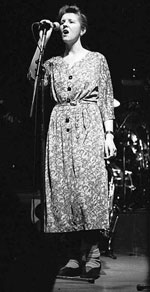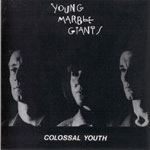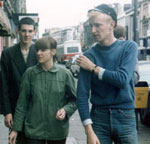
Photo: Jos Van Vliet
In Sounds Dave McCullough excitedly wrote: “In one album Swell Maps tell us that they are on the same wavelength with the brave new-world fighters. They are a part of the contemporary underground, overground, centreground rock and roll battle, as vicious as the snake they hunt, armed steady with a cutting, wild insight, thrusting with a blind accuracy at the industry's fat, sweaty machines.”
A year on, and Rough Trade’s latest trump card, the Young Marble Giants’ Colossal Youth set, was a very different one. McCullough was scribbling excitedly again about this “imaginatively unflustered music” and the “extravagant sparsity”. He wrote how the music was evocative of “tiny Welsh tearooms, childhood fear, coffee bar intimacy, murder, lost love, sleep, tension and longing constantly underlined by an enduring eeriness in the music.”
Colossal Youth remains one of the most startling of records. The stripped down instrumentation, and minimal beats and electronics still shock. But it is the voice and presence of singer Alison Statton that still has the most impact. Much has been written about her seeming sense of insouciance and grace, but that detracts from a unique pop personality of great poise and style, as captured on the live film footage of the Young Marble Giants from their dates at the Hurrah Club in New York, where she just looks so right for the unprecedented music.
More so than her YMG colleagues Alison would continue to remain a symbol of what I have long argued was essentially the only possible revolution beyond punk. It was a revolution against the pomposity, bluster and bombast of orthodox rock. It was a revolt into a quiet creativity, which was more about Burt Bacharach, Carpenters, jazz, folk, highlife and bossa. Imaginaries like Alison Statton, Vic Godard, and the Postcard Records stable would challenge every known rock convention, and argue for an imaginative new pop that would reach all generations.

I would best capture the feel of Weekend by using some words of Tropicalia hero Fernando Pessao, which I stumbled across the other day. The passage haunted me like a lost Weekend song. It went: “In the lingering summer evenings, I love the quiet of this commercial part of town, all the more because it’s such a contrast with the noisy bustle that fills it during the day. Rua do Arsenal, Rua de Alfandega, the sad roads that reach out to the east where the Alfandega ends, and the long solitary line of quiet quays: they comfort me with sadness on those evenings when I choose to share their solitude.”
Pretentious perhaps appropriating Pessoa, but the music of Weekend does evoke the new bohemianism Geoff Dyer captures in his The Colour of Memory, and which other groups like the Swamp Children/Kalima caught in footage of a monochrome Manchester that’s now long gone. An old Coltrane tune playing in a deserted warehouse as a solitary figure dances. Where work is eschewed in favour of dreaming, and there are far too many books, records, and films to catch up on anyway.
After the Weekend was over, Alison Statton would be rescued by Ian Devine to make a couple of records for the Crepescule imprint. Devine may be best known now for his quote in Michael Bracewell’s The Nineties where he says his ultimate aim is “cultural disengagement” “I want to not know who Hugh Grant is.” But long before that he was part of Ludus, deadly serious mischief makers from Manchester, led by artful agitator Linder. She maybe better known now for her photos of Morrissey (a huge Ludus fan if I had my wits about me I’d still have the article he wrote on Ludus for Irish fanzine Vox under the pen name of Sheridan Whiteside, and which contained many of the phrases he would use in the early days of the Smiths) than for the madly inventive pop she was part of, but the Ludus records have worn remarkably well.

photo: Andrew Tucker
Myself I prefer the records Alison would go on to make with her old Weekend comrade Spike for the distinctly odd Vinyl Japan label (home too to another goddess temporarily when Fay Hallam would record for them as Phaze). These records explore further the folk and jazz ballads roots which had previously been hinted at, and which if explored in whatever direction would lead to Bridget St John and Shelagh MacDonald, Nara Leao and Joyce, Sheila Jordan and Anita O’Day, Robert Wyatt and Richard Thompson.
And it’s funny just taking that one stage further, in the early days of Rough Trade it was almost heretical and incredibly brave to compare Scritti Politti to Henry Cow, Hatfield and the North, and Richard Thompson, and make connections between the Raincoats and Young Marble Giants and Sandy Denny and Fairport Convention. Yet in next to no time Pere Ubu’s David Thomas would make these links explicit with the personnel on his solo Rough Trade sets, and Robert Wyatt would be making a series of exceptionally lovely recordings for Rough Trade.
© 2006 John Carney
Thanks to Mike Applestein's peerless 'Cardiffians' website for photos.